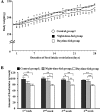Time Restriction of Food Intake During the Circadian Cycle Is a Possible Regulator of Reproductive Function in Postadolescent Female Rats
- PMID: 30963143
- PMCID: PMC6446981
- DOI: 10.1093/cdn/nzy093
Time Restriction of Food Intake During the Circadian Cycle Is a Possible Regulator of Reproductive Function in Postadolescent Female Rats
Abstract
Background: We previously reported that skipping breakfast is associated with menstrual disorders of female college students during postadolescent maturation.
Objective: In this study, we investigated the effects of meal timing during circadian cycle on the ovarian function using young female rats.
Methods: Considering that rats are nocturnally active, 8-wk-old female Wistar rats were classified into 3 groups: fed during the daytime only (nonactive phase), night-time only (active phase), or control group I (without time or calorie restriction, free access to a standard caloric diet, 20.0% protein, 62.9% carbohydrate, and 7.0% fat, 3.95 kcal/g) for 4 wk. The changes in body weight and frequency of ovulation in each group were evaluated by a weight scale and a vaginal smear, respectively. At the end of the period of dietary restriction, ovaries were removed, and the numbers of growing follicles (mean diameter >250 µm) and corpora lutea (>600 µm) were examined using hematoxylin-eosin-stained tissue sections. In addition, 8-wk-old female rats were fed only during the night-time for 4 wk under a 20%-reduced food supply of the control group II (without any restriction).
Results: In the daytime-fed group, the frequency and number of ovulations were significantly decreased compared with those in the control group I (P < 0.05), with a reduced body weight gain concomitant with about 20% of reduction in the daily food intake. In contrast, in the night-time-fed group, even when a 20% reduction in the daily food intake was loaded, their estrus cyclicity did not change despite significant reductions in weight gain and food intake compared with control group II.
Conclusion: These findings indicate that restricting food intake to the inactive phase impairs ovarian function in postadolescent female rats, suggesting that the timing of food intake during circadian cycle is one of the crucial factors interfering with the reproductive function.
Keywords: active phase; circadian rhythms; dietary restriction; ovarian function; postadolescent rat; weight gain.
Figures




Similar articles
-
Delayed first cycle in intrauterine growth-retarded and postnatally undernourished female rats: follicular growth and ovulation after stimulation with pregnant mare serum gonadotropin at first cycle.J Endocrinol. 2002 May;173(2):297-304. doi: 10.1677/joe.0.1730297. J Endocrinol. 2002. PMID: 12010637
-
Phase-advanced daily rhythms of melatonin, body temperature, and locomotor activity in food-restricted rats fed during daytime.J Biol Rhythms. 1997 Feb;12(1):65-79. doi: 10.1177/074873049701200108. J Biol Rhythms. 1997. PMID: 9104691
-
Daily meal timing is not necessary for resetting the main circadian clock by calorie restriction.J Neuroendocrinol. 2008 Feb;20(2):251-60. doi: 10.1111/j.1365-2826.2007.01636.x. Epub 2007 Dec 7. J Neuroendocrinol. 2008. PMID: 18088363
-
NTP Developmental and Reproductive Toxicity Technical Report on the Modified One-Generation Study of Bisphenol AF (CASRN 1478-61-1) Administered in Feed to Sprague Dawley (Hsd:Sprague Dawley® SD®) Rats with Prenatal, Reproductive Performance, and Subchronic Assessments in F1 Offspring: DART Report 08 [Internet].Research Triangle Park (NC): National Toxicology Program; 2022 Sep. Research Triangle Park (NC): National Toxicology Program; 2022 Sep. PMID: 36383702 Free Books & Documents. Review.
-
NTP Developmental and Reproductive Toxicity Technical Report on the Modified One-Generation Study of 2-Hydroxy-4-methoxybenzophenone (CASRN 131-57-7) Administered in Feed to Sprague Dawley (Hsd:Sprague Dawley® SD®) Rats with Prenatal and Reproductive Performance Assessments in F1 Offspring: DART Report 05 [Internet].Research Triangle Park (NC): National Toxicology Program; 2022 Jun. Research Triangle Park (NC): National Toxicology Program; 2022 Jun. PMID: 35877944 Free Books & Documents. Review.
Cited by
-
The Circadian Clock, Nutritional Signals and Reproduction: A Close Relationship.Int J Mol Sci. 2023 Jan 12;24(2):1545. doi: 10.3390/ijms24021545. Int J Mol Sci. 2023. PMID: 36675058 Free PMC article. Review.
-
Skipping the first active meal appears to adversely alter reproductive function in female than male rats.Curr Res Physiol. 2022 Oct 4;5:414-420. doi: 10.1016/j.crphys.2022.10.001. eCollection 2022. Curr Res Physiol. 2022. PMID: 36267644 Free PMC article.
-
Adolescent Dietary Habit-induced Obstetric and Gynecologic Disease (ADHOGD) as a New Hypothesis-Possible Involvement of Clock System.Nutrients. 2020 May 2;12(5):1294. doi: 10.3390/nu12051294. Nutrients. 2020. PMID: 32370105 Free PMC article.
-
Breakfast Skipping in Female College Students Is a Potential and Preventable Predictor of Gynecologic Disorders at Health Service Centers.Diagnostics (Basel). 2020 Jul 13;10(7):476. doi: 10.3390/diagnostics10070476. Diagnostics (Basel). 2020. PMID: 32668795 Free PMC article.
-
Time-Restricted Feeding Regulates Circadian Rhythm of Murine Uterine Clock.Curr Dev Nutr. 2021 Apr 9;5(5):nzab064. doi: 10.1093/cdn/nzab064. eCollection 2021 May. Curr Dev Nutr. 2021. PMID: 33981944 Free PMC article.
References
-
- Das JK, Salam RA, Thornburg KL, Prentice AM, Campisi S, Lassi ZS, Koletzko B, Bhutta ZA. Nutrition in adolescents: Physiology, metabolism, and nutritional needs. Ann NY Acad Sci 2017;1393:21–33. - PubMed
-
- Fujiwara T. Diet during adolescence is a trigger for subsequent development of dysmenorrhea in young women. Int J Food Sci Nutr 2007;58:437–44. - PubMed
-
- Wärnberg J, Nova E, Romeo J, Moreno LA, Sjöström M, Marcos A. Lifestyle-related determinants of inflammation in adolescence. Br J Nutr 2007;98(Suppl 1):S116–120. - PubMed
LinkOut - more resources
Full Text Sources

